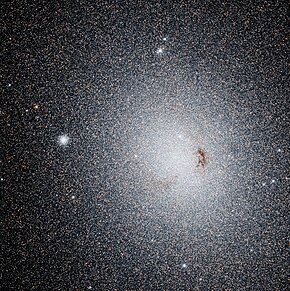| NGC 185 | |
|---|---|
 NGC 185 imaged by the Hubble Space Telescope | |
| Observation data (J2000.0[1] epoch) | |
| Constellation | Cassiopeia |
| Right ascension | 00h 38m 57.970s[1] |
| Declination | +48° 20′ 14.56″[1] |
| Redshift | −202 ± 3 km/s[2] |
| Distance | 2.05 ± 0.13 Mly (630 ± 40 kpc)[3][4][5][a] |
| Apparent magnitude (V) | 10.1[2] |
| Characteristics | |
| Type | dSph/dE3,[2] Sy2 [1] |
| Apparent size (V) | 11.7′ × 10.0′[2] |
| Notable features | Satellite galaxy of the Andromeda Galaxy |
| Other designations | |
| UGC 396,[2] PGC 2329,[2] LEDA 2329,[1] Caldwell 18 | |
NGC 185 (also known as Caldwell 18) is a dwarf spheroidal galaxy located 2.08 million light-years from Earth, appearing in the constellation Cassiopeia. It is a member of the Local Group, and is a satellite of the Andromeda Galaxy (M31).[6] NGC 185 was discovered by William Herschel on November 30, 1787, and he cataloged it "H II.707".[6] John Herschel observed the object again in 1833 when he cataloged it as "h 35", and then in 1864 when he cataloged it as "GC 90" within his General Catalogue of Nebulae and Clusters.[6] NGC 185 was first photographed between 1898 and 1900 by James Edward Keeler with the Crossley Reflector of Lick Observatory.[6] Unlike most dwarf elliptical galaxies, NGC 185 contains young stellar clusters, and star formation proceeded at a low rate until the recent past. NGC 185 has an active galactic nucleus (AGN) and is usually classified as a type 2 Seyfert galaxy,[7] though its status as a Seyfert is questioned.[8] It is possibly the closest Seyfert galaxy to Earth, and is the only known Seyfert in the Local Group.
- ^ a b c d e "NGC 185". SIMBAD. Centre de données astronomiques de Strasbourg. Retrieved 2014-05-05.
- ^ a b c d e f "NASA/IPAC Extragalactic Database". Results for NGC 185. Retrieved 2006-11-29.
- ^ Cite error: The named reference
tonryetal2001was invoked but never defined (see the help page). - ^ Cite error: The named reference
karachentsevetal2004was invoked but never defined (see the help page). - ^ Cite error: The named reference
Karachentsevetal2006was invoked but never defined (see the help page). - ^ a b c d "SEDS — NGC 185".
- ^ Ho, Luis C.; Filippenko, Alexei V.; Sargent, Wallace L. W. (October 1997). "A Search for 'Dwarf' Seyfert Nuclei. III. Spectroscopic Parameters and Properties of the Host Galaxies". The Astrophysical Journal Supplement Series. 112 (2): 315–390. arXiv:astro-ph/9704107. Bibcode:1997ApJS..112..315H. doi:10.1086/313041. S2CID 17086638.
- ^ Martins, Lucimara P.; Lanfranchi, Gustavo; Goncalves, Denise R.; Magrini, Laura; Teodorescu, Ana M.; Quireza, Cintia (February 2012). "The ionization mechanism of NGC 185: How to fake a Seyfert galaxy?". Monthly Notices of the Royal Astronomical Society. 419 (4): 3159–3166. arXiv:1110.5891. Bibcode:2012MNRAS.419.3159M. doi:10.1111/j.1365-2966.2011.19954.x. S2CID 119188037.